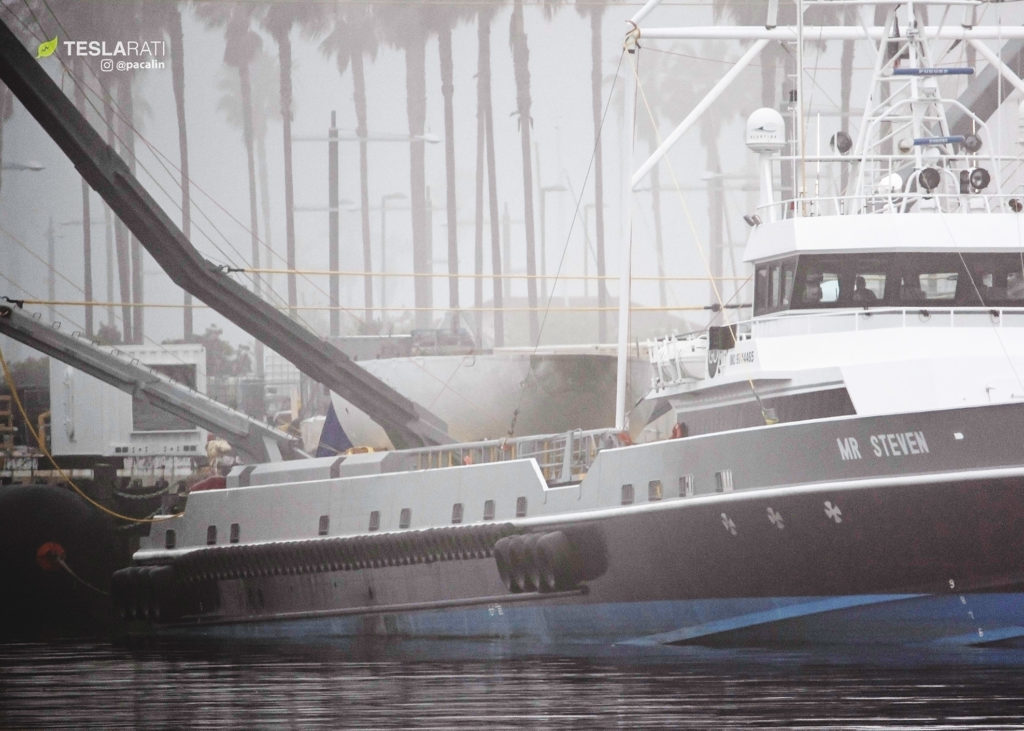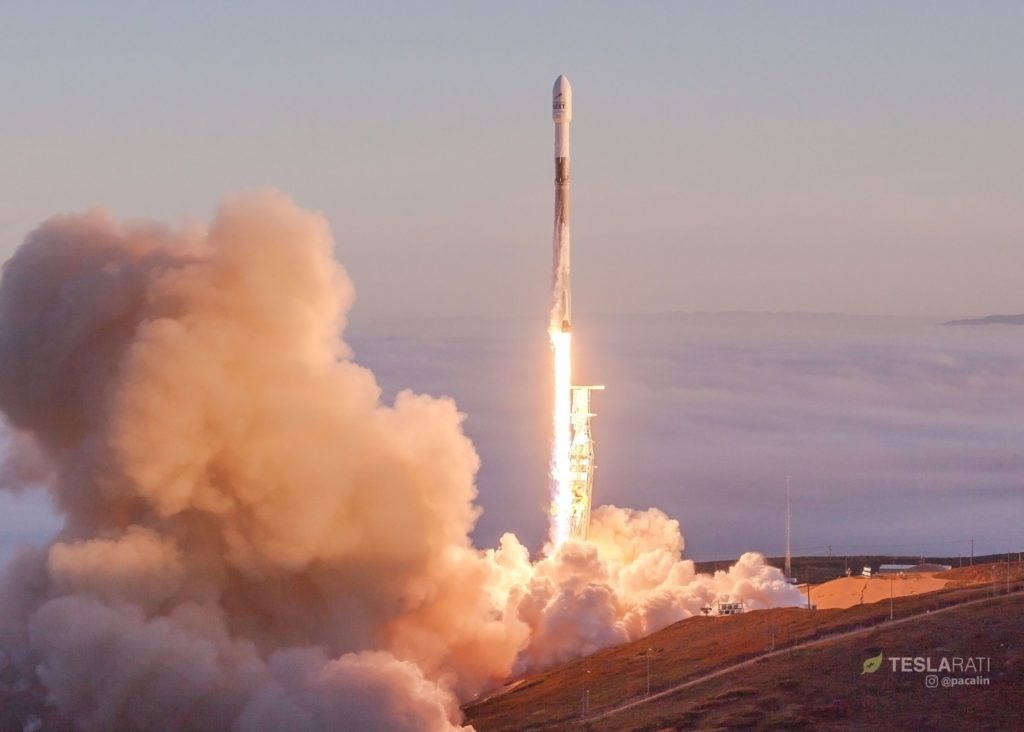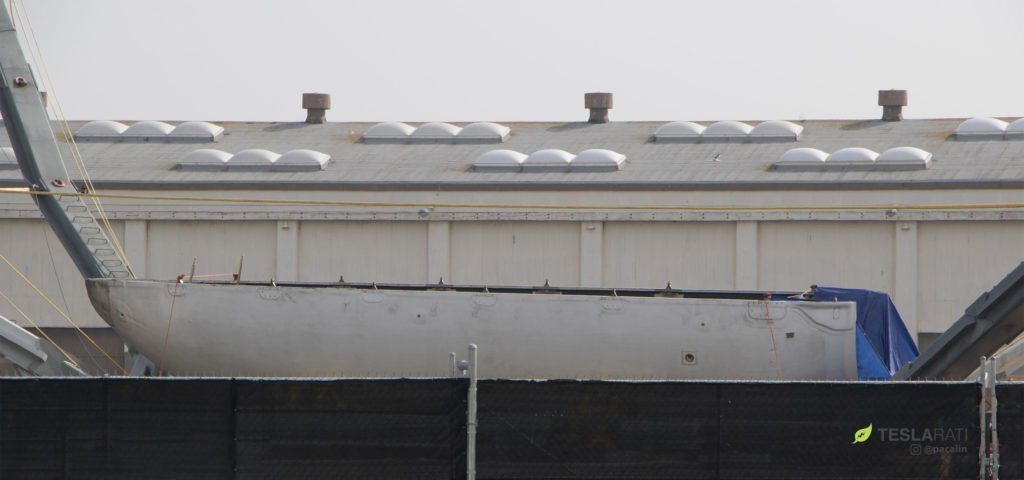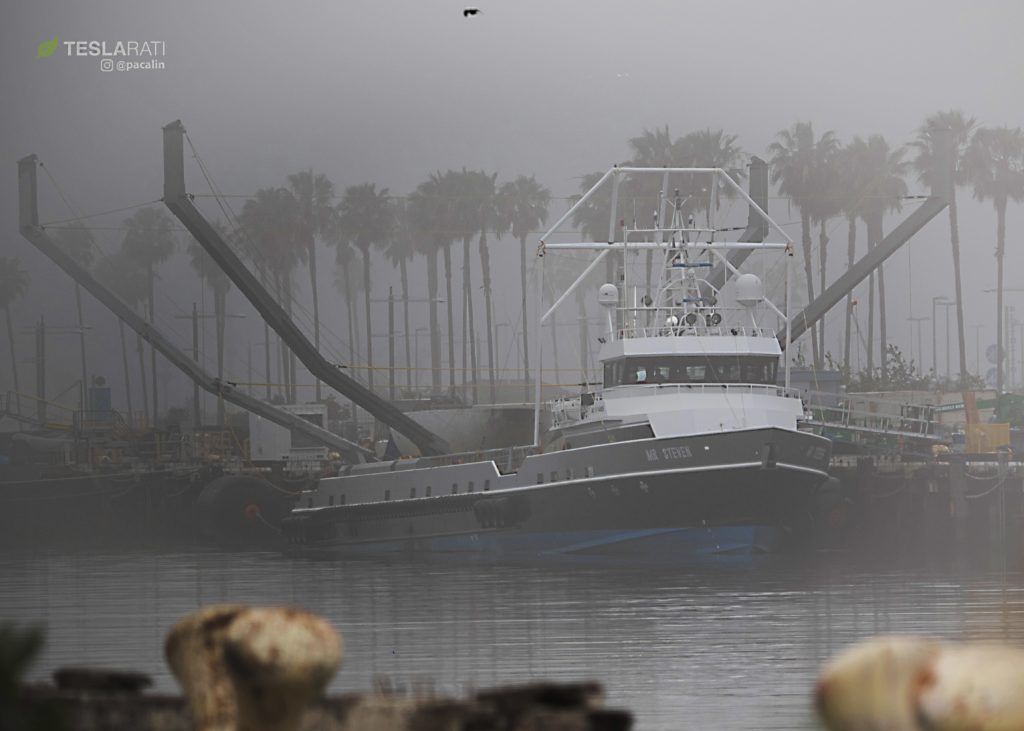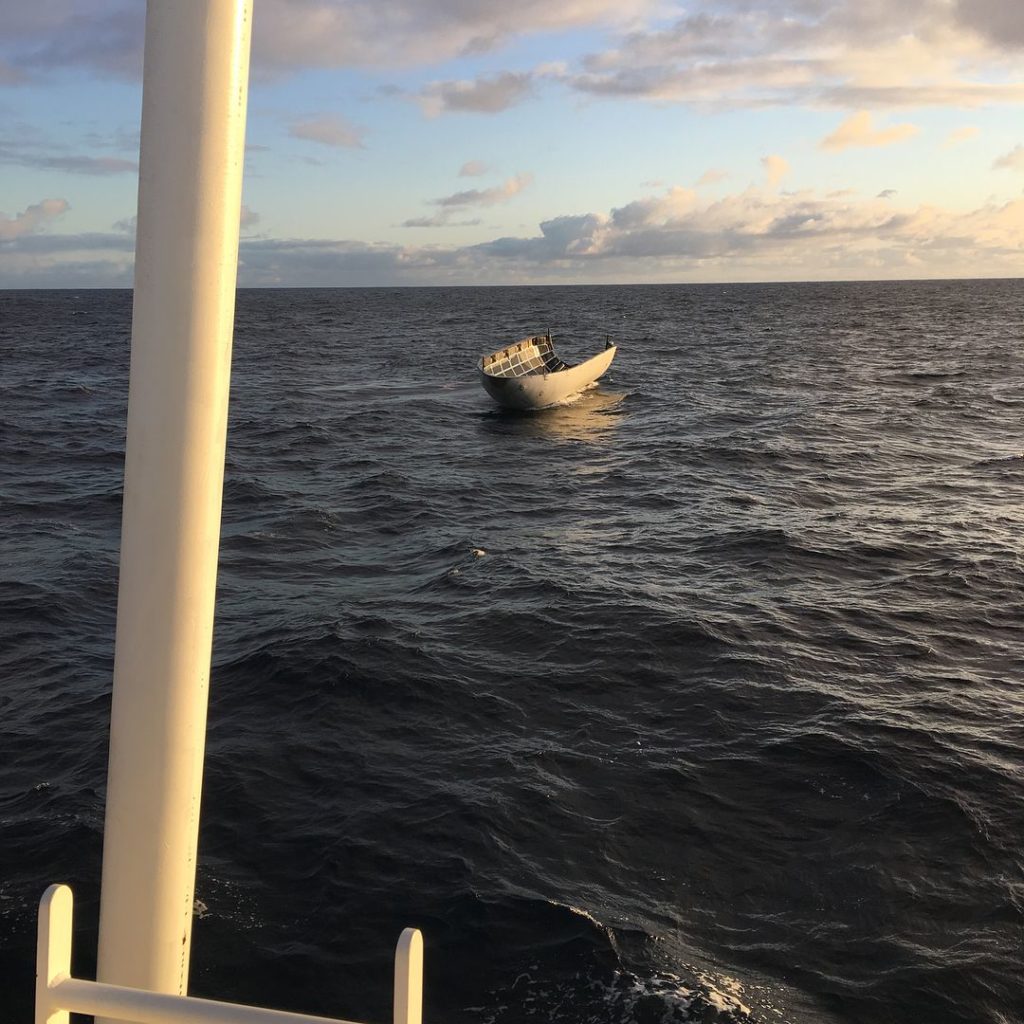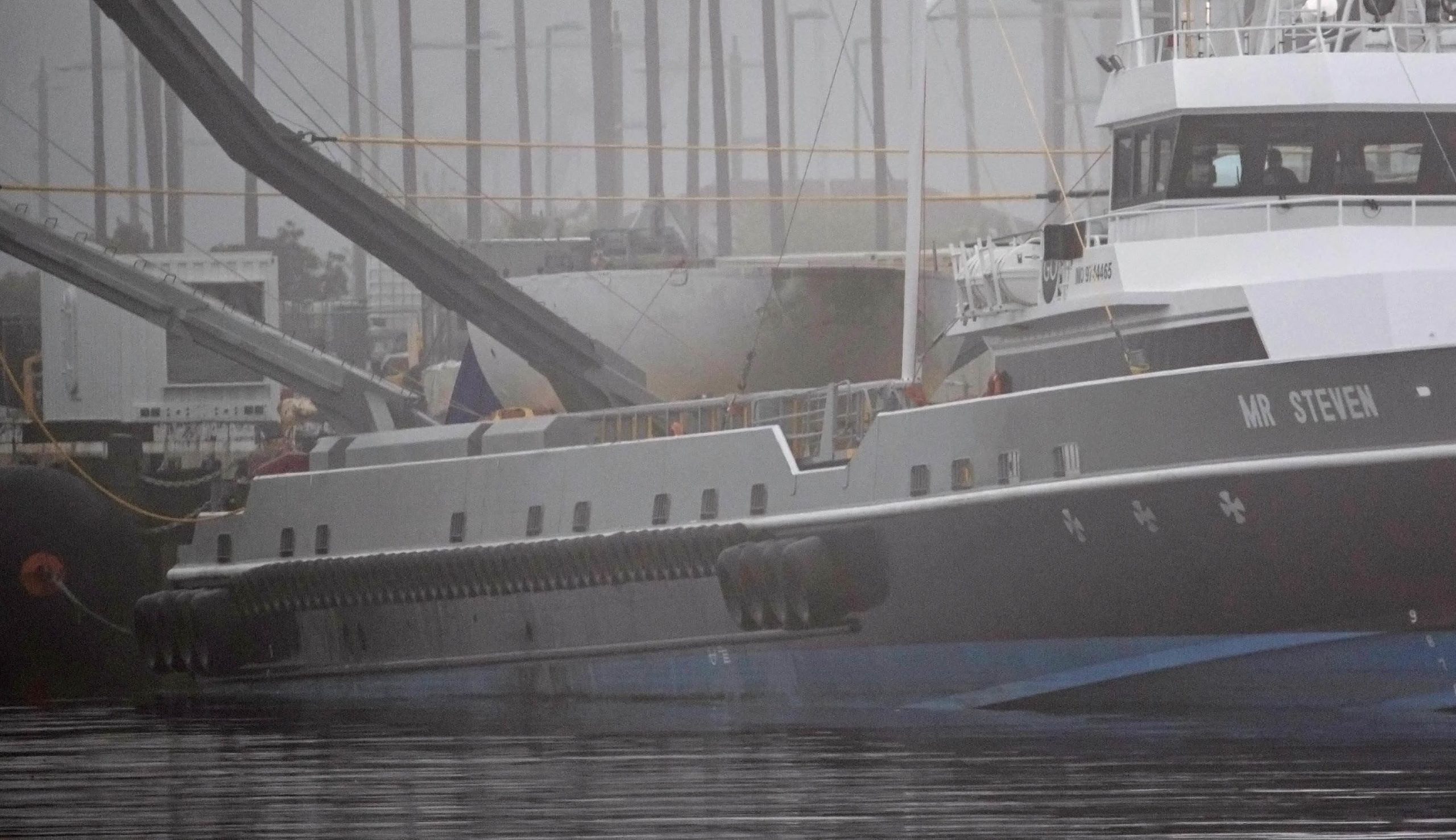
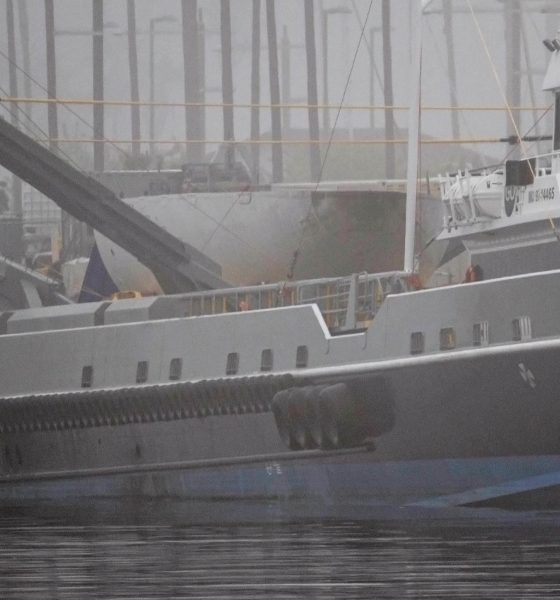
News
SpaceX returns intact fairing half on clawboat in post-launch surprise
Despite a statement from SpaceX CEO Elon Musk that the Iridium-5 mission’s fairing recovery attempt had failed due to a twisted parafoil, Teslarati captured photos of clawboat Mr Steven arriving in the Port of San Pedro early Saturday morning with an apparently intact fairing half.
Not to be confused with the first successfully recovered fairing that returned to land in late February, this half is undoubtedly fresh from Iridium-5’s Friday morning launch. The $2.5 million, carbon composite aluminum fairing half recovered during SpaceX’s PAZ mission on February 22 is currently being stored and scrapped at SpaceX’s brand new port real estate – Berth 240, or the same location that was selected as the probable location for SpaceX’s first BFR manufacturing facility.
- The Iridium-5 half, however, is not believed to have suffered any significant structural damage during recovery ops. (Pauline Acalin)
- Falcon 9 1041 rises above a sea of fog for one last mission to orbit. Half of its fairing made a surprise appearance in port on Saturday. (Pauline Acalin)
- An unmistakable Falcon 9 fairing half seen aboard the vessel Mr Steven on Saturday morning. (Pauline Acalin)
- Teslarati photographer Pauline Acalin made her way to a foggy Port of San Pedro early Saturday morning to welcome Mr Steven home. (Pauline Acalin)
Compared to Musk’s previous comments during the first intact fairing recovery in late February, it would seem that Iridium-5’s fairing was all but doomed when it “impacted [the] water at high speed,” and the majority of fans appeared to have concluded as much. Following PAZ, Musk tweeted that the Mr Steven had “missed by a few hundred meters, but fairing landed intact in water” – as an incredibly optimized and lightweight structure, a fairing half would likely have to land very gently to avoid breaking into pieces. That Mr Steven’s crew was able to bring the Iridium-5 half aboard all but guarantees that it was floating intact on the ocean surface after touching down.
GPS guided parafoil twisted, so fairing impacted water at high speed. Air wake from fairing messing w parafoil steering. Doing helo drop tests in next few weeks to solve.
— Elon Musk (@elonmusk) March 30, 2018
This does not necessarily contradict Musk’s diagnosis of a twisted parafoil, assuming he was referring to the lines that connect the fairing to the foil – paragliders frequently suffer tangles and twists in their lines, an event that typically warps the parafoil’s structure, thus lowering the amount of lift it can produce as a wing. This is an inevitable risk of what is basically a self-inflating wing, and failures of this sort are known to kill or injure paragliders at low altitudes and can also lead to uncontrolled spinning (although that is very unlikely to occur with a 1000kg payload).
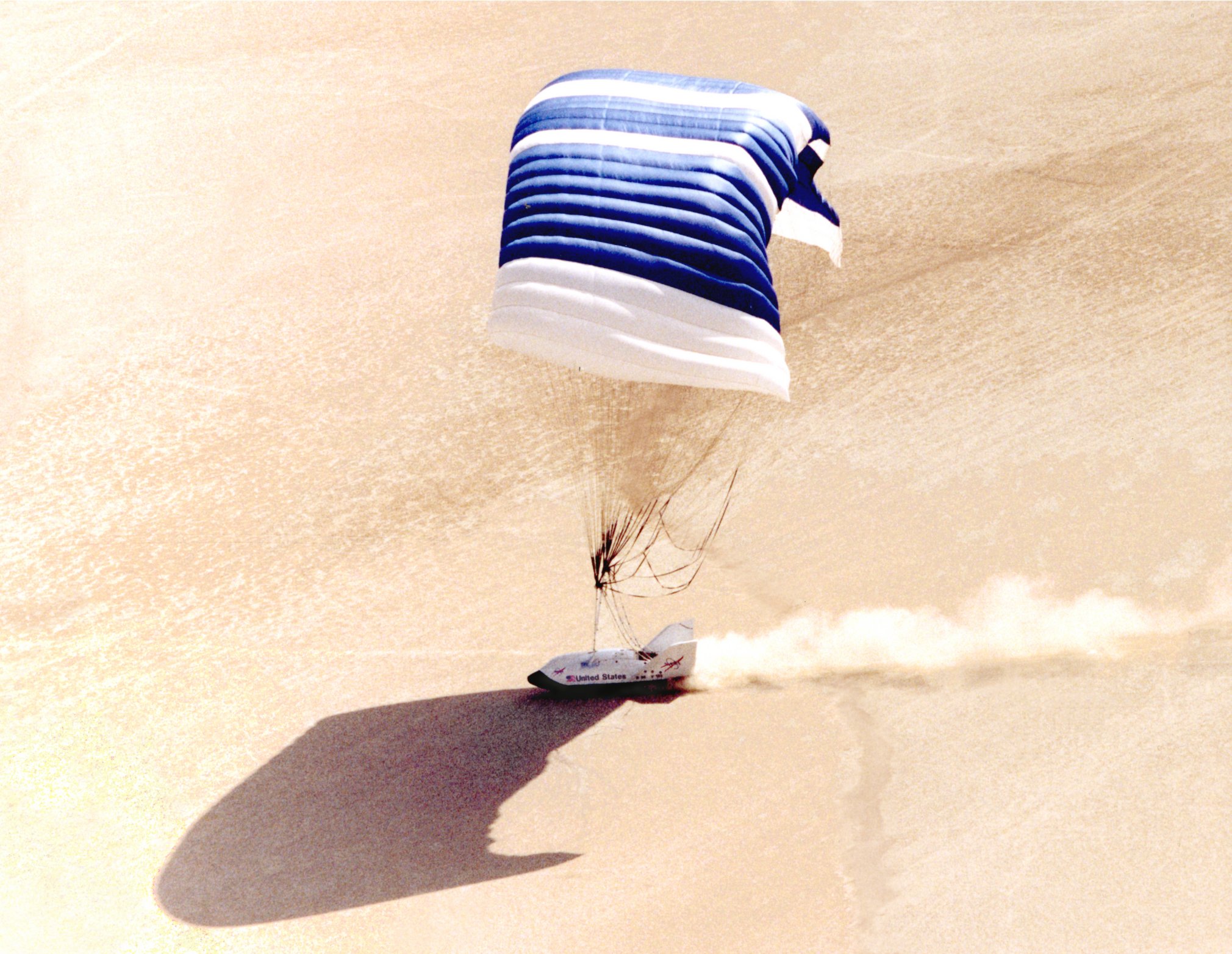
A NASA experiment in the late 90s examined the use of a parafoil to enable gentle, guided landings of an orbital escape pod – the experiment was quite successful. (NASA)
Ultimately, GPS-guided parafoils have been done fairly successfully and many times over during the past two or so decades. For the most part,the problems preventing SpaceX from recovering fairings in Mr Steven’s net have been almost entirely solved: the fact that two fairing halves have been recovered intact after their last two Western launches confirm as much. SpaceX engineers have somehow found a way to enable a highly flexible, lightweight, and aerodynamically awkward lifting body to survive a journey from heights of 110+ km and speeds of more than 2250 meters per second.
SpaceX’s fairings may look unassuming dressed in their subtle soot and simple curved lines, but – as SpaceX has intoned in the past – if landing massive Falcon 9 boosters after launch is akin to “launching a pencil over the Empire State building and having it land on a shoebox on the other side…during a wind storm,” recovering the relatively minuscule and light fairings can be fairly compared to launching a paper bowl over two stacked Empire State Buildings in a tornado and catching it with one hand behind your back on the opposite side – all without ripping, folding, or denting it.
- It may look unassuming, but that fairing half could swallow an entire school bus and by all means should not be in one piece. (Fairing from PAZ, photo by Elon Musk)
- Falcon 9 B1041.2 seen before launching Iridium-5. (Pauline Acalin)
SpaceX is 99% of the way to successful and routine fairing recovery and reuse and the final 1% is all about testing and subtle refinement. Future fairing recovery attempts may even be streamed in real time on SpaceX’s webcasts, according to Musk.
Follow us for live updates, behind-the-scenes sneak peeks, and a sea of beautiful photos from our East and West coast photographers.
Teslarati – Instagram – Twitter
Tom Cross – Twitter
Pauline Acalin – Twitter
Eric Ralph – Twitter

Elon Musk
GM CEO Mary Barra says she told Biden to give Tesla and Musk EV credit
“He was crediting me, and I said, ‘Actually, I think a lot of that credit goes to Elon and Tesla…You know me, Andrew. I don’t want to take credit for things.”
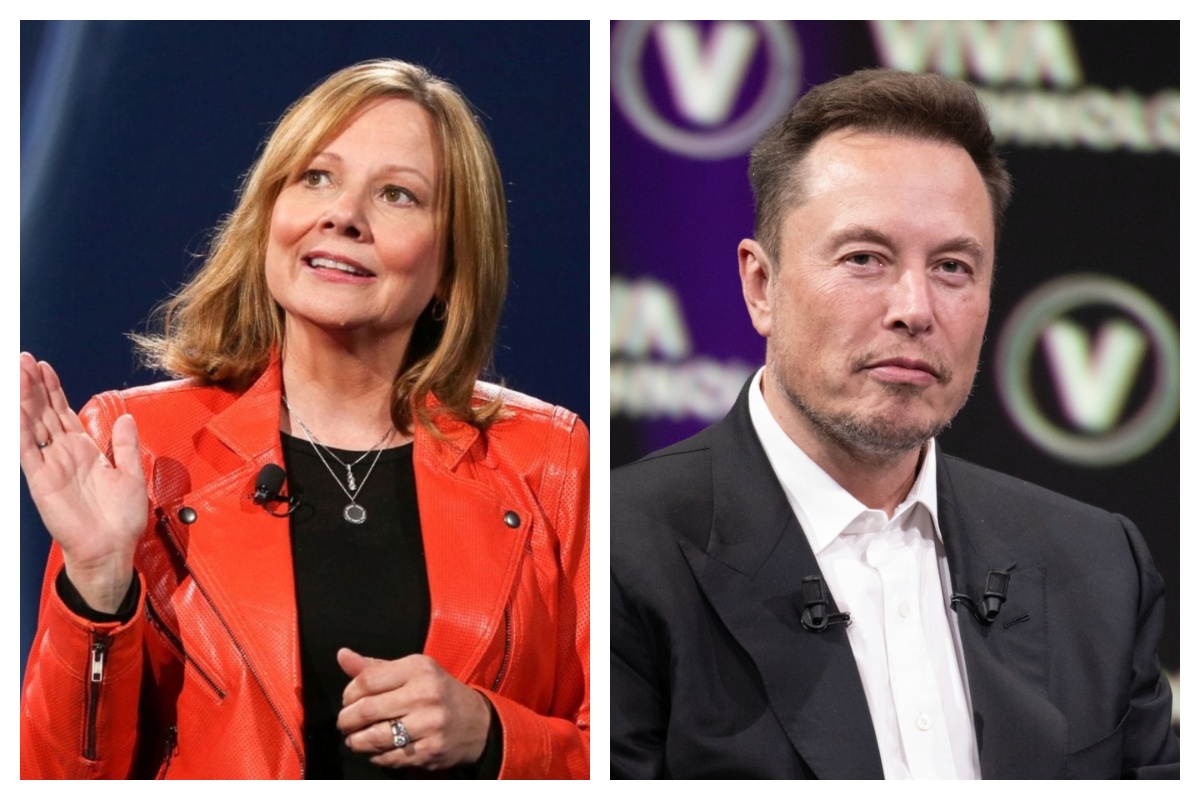
General Motors CEO Mary Barra said in a new interview on Wednesday that she told President Joe Biden to credit Tesla and its CEO, Elon Musk, for the widespread electric vehicle transition.
She said she told Biden this after the former President credited her and GM for leading EV efforts in the United States.
During an interview at the New York Times Dealbook Summit with Andrew Ross Sorkin, Barra said she told Biden that crediting her was essentially a mistake, and that Musk and Tesla should have been explicitly mentioned (via Business Insider):
“He was crediting me, and I said, ‘Actually, I think a lot of that credit goes to Elon and Tesla…You know me, Andrew. I don’t want to take credit for things.”
GM CEO Mary Barra said to Andrew Sorkin at the New York Times Dealbook Summit that she pulled President Biden aside and said Tesla CEO @elonmusk deserved the credit for EVs:
“He was crediting me, and I said, ‘Actually, I think a lot of that credit goes to Elon and Tesla,’” Barra… pic.twitter.com/OHBTG1QfbJ
— TESLARATI (@Teslarati) December 3, 2025
Back in 2021, President Biden visited GM’s “Factory Zero” plant in Detroit, which was the centerpiece of the company’s massive transition to EVs. The former President went on to discuss the EV industry, and claimed that GM and Barra were the true leaders who caused the change:
“In the auto industry, Detroit is leading the world in electric vehicles. You know how critical it is? Mary, I remember talking to you way back in January about the need for America to lead in electric vehicles. I can remember your dramatic announcement that by 2035, GM would be 100% electric. You changed the whole story, Mary. You did, Mary. You electrified the entire automotive industry. I’m serious. You led, and it matters.”
People were baffled by the President’s decision to highlight GM and Barra, and not Tesla and Musk, who truly started the transition to EVs. GM, Ford, and many other companies only followed in the footsteps of Tesla after it started to take market share from them.
Elon Musk and Tesla try to save legacy automakers from Déjà vu
Musk would eventually go on to talk about Biden’s words later on:
“They have so much power over the White House that they can exclude Tesla from an EV Summit. And, in case the first thing, in case that wasn’t enough, then you have President Biden with Mary Barra at a subsequent event, congratulating Mary for having led the EV revolution.”
In Q4 2021, which was shortly after Biden’s comments, Tesla delivered 300,000 EVs. GM delivered just 26.
News
Tesla Full Self-Driving shows confident navigation in heavy snow
So far, from what we’ve seen, snow has not been a huge issue for the most recent Full Self-Driving release. It seems to be acting confidently and handling even snow-covered roads with relative ease.
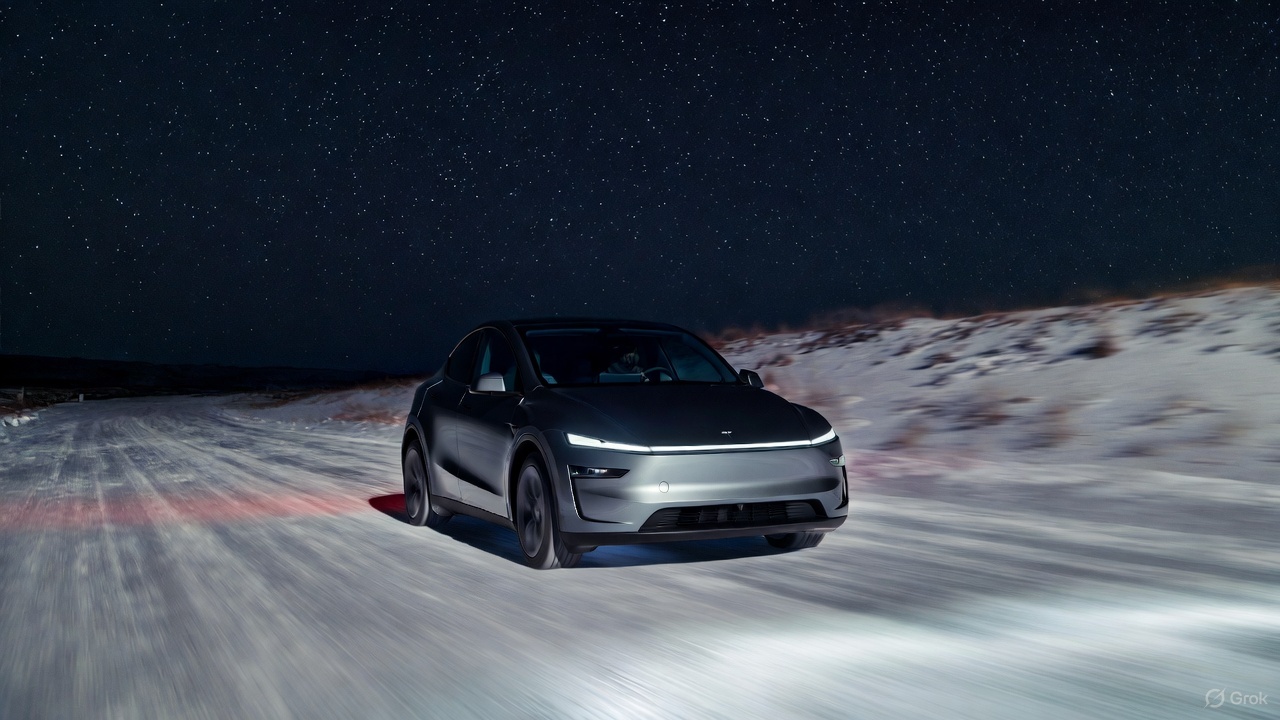
Tesla Full Self-Driving is getting its first taste of Winter weather for late 2025, as snow is starting to fall all across the United States.
The suite has been vastly improved after Tesla released v14 to many owners with capable hardware, and driving performance, along with overall behavior, has really been something to admire. This is by far the best version of FSD Tesla has ever released, and although there are a handful of regressions with each subsequent release, they are usually cleared up within a week or two.
Tesla is releasing a modified version of FSD v14 for Hardware 3 owners: here’s when
However, adverse weather conditions are something that Tesla will have to confront, as heavy rain, snow, and other interesting situations are bound to occur. In order for the vehicles to be fully autonomous, they will have to go through these scenarios safely and accurately.
One big issue I’ve had, especially in heavy rain, is that the camera vision might be obstructed, which will display messages that certain features’ performance might be degraded.
So far, from what we’ve seen, snow has not been a huge issue for the most recent Full Self-Driving release. It seems to be acting confidently and handling even snow-covered roads with relative ease:
FSD 14.1.4 snow storm Ontario Canada pic.twitter.com/jwK1dLYT0w
— Everything AI (@mrteslaspace) November 17, 2025
I found the steepest, unplowed hill in my area and tested the following:
• FSD 14.2.1 on summer tires
• FSD 14.2.1 on winter tires
• Manual drivingBut I think the most impressive part was how FSD went DOWN the hill. FSD in the snow is sublime $TSLA pic.twitter.com/YMcN7Br3PU
— Dillon Loomis (@DillonLoomis) December 2, 2025
Well.. I couldn’t let the boys have all the fun!
Threw the GoPro up and decided to FSD v14.2.1 in the snow. Roads were not compacted like the other day, a little slippery, but overall doable at lower speeds. Enjoy the video and holiday music 🎶
Liked:
Took turns super slow… pic.twitter.com/rIAIeh3Zu3— 🦋Diana🦋 (@99_Colorado) December 3, 2025
Moving into the winter months, it will be very interesting to see how FSD handles even more concerning conditions, especially with black ice, freezing rain and snow mix, and other things that happen during colder conditions.
We are excited to test it ourselves, but I am waiting for heavy snowfall to make it to Pennsylvania so I can truly push it to the limit.
News
Tesla hosts Rome Mayor for first Italian FSD Supervised road demo
The event marked the first time an Italian mayor tested the advanced driver-assistance system in person in Rome’s urban streets.
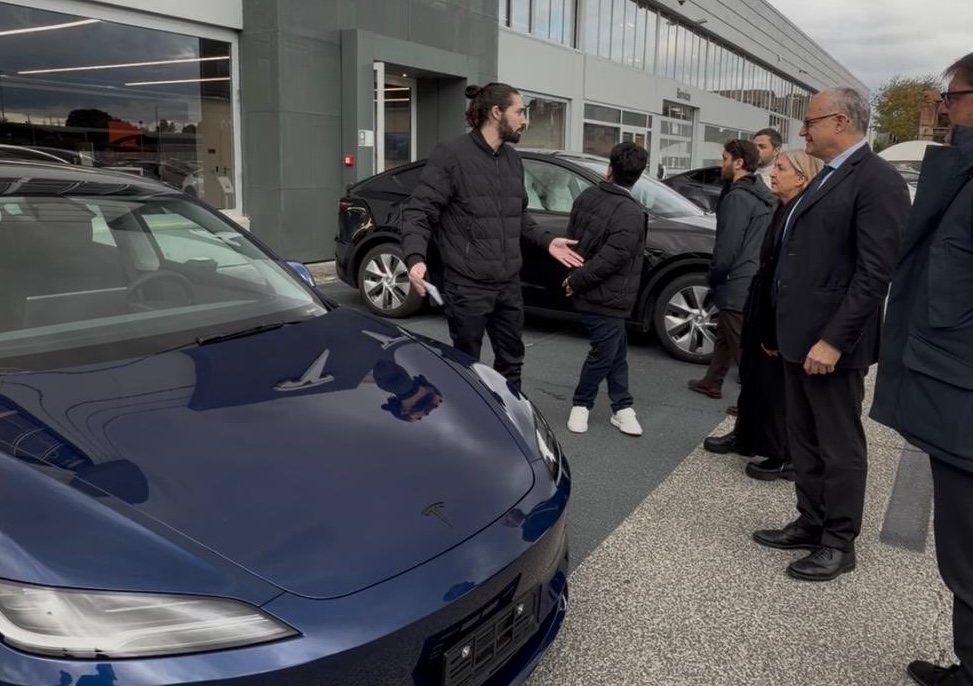
Tesla definitely seems to be actively engaging European officials on FSD’s capabilities, with the company hosting Rome Mayor Roberto Gualtieri and Mobility Assessor Eugenio Patanè for a hands-on road demonstration.
The event marked the first time an Italian mayor tested the advanced driver-assistance system in person in Rome’s urban streets. This comes amid Tesla’s push for FSD’s EU regulatory approvals in the coming year.
Rome officials experience FSD Supervised
Tesla conducted the demo using a Model 3 equipped with Full Self-Driving (Supervised), tackling typical Roman traffic including complex intersections, roundabouts, pedestrian crossings and mixed users like cars, bikes and scooters.
The system showcased AI-based assisted driving, prioritizing safety while maintaining flow. FSD also handled overtakes and lane decisions, though with constant driver supervision.
Investor Andrea Stroppa detailed the event on X, noting the system’s potential to reduce severe collision risks by up to seven times compared to traditional driving, based on Tesla’s data from billions of global fleet miles. The session highlighted FSD’s role as an assistance tool in its Supervised form, not a replacement, with the driver fully responsible at all times.
Path to European rollout
Tesla has logged over 1 million kilometers of testing across 17 European countries, including Italy, to refine FSD for local conditions. The fact that Rome officials personally tested FSD Supervised bodes well for the program’s approval, as it suggests that key individuals are closely watching Tesla’s efforts and innovations.
Assessor Patanè also highlighted the administration’s interest in technologies that boost road safety and urban travel quality, viewing them as aids for both private and public transport while respecting rules.
Replies on X urged involving Italy’s Transport Ministry to speed approvals, with one user noting, “Great idea to involve the mayor! It would be necessary to involve components of the Ministry of Transport and the government as soon as possible: it’s they who can accelerate the approval of FSD in Italy.”
